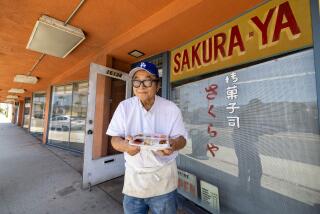Ninagawa Finds Recognition Abroad : Yukio Ninagawa Finds Recognition Abroad : Stage: The Japanese director of ‘Sotoba Komachi’ at Japan America Theatre has found success everywhere but in his own country.
American jazz players perennially lament that they have to go abroad to be appreciated. Often, that means going to Japan.
Now, a Japanese theater director, Yukio Ninagawa, believes he must go abroad to find an appreciative audience--and critics. His travels have finally brought him to Los Angeles, where his Ninagawa Company will present Yukio Mishima’s modernized re-telling of the Noh drama “Sotoba Komachi” tonight and Saturday at Japan America Theatre.
For the last 10 years, it’s been a love feast between Western theatergoers and the Ninagawa Company.
The (London) Guardian’s Michael Billington declared that “Ninagawa has been the Edinburgh Festival’s great discovery of the ‘80s . . . What makes Ninagawa a great director . . . is that he combines a gift for total theater with a poetic sensitivity towards change and decay.”
British critics, having viewed Ninagawa’s many takes on the classics (“Medea,” “The Tempest,” “Macbeth”), as well as last year’s “Komachi,” matter-of-factly refer to him as one of the world’s top directors, in the league of Peter Brook and Georgio Strehler.
But back home, it’s a different story. Relaxing in a lounge room at Japan America Theatre and speaking through a translator, the trim, black-garbed director says: “I’m really not admired in Japan. Our critics would have seen O’Neill in America or Shakespeare in England, and it’s set in their mind that that’s how it should be done. For my postwar generation, we reject that kind of rigidity. The world is my audience, and I try to make sure that all my work speaks to today.”
Ninagawa’s producer, Tadao Nakane, explains that “for many years, the Japanese cultural elite felt proprietary about Western work, so that Shakespeare, for instance, was always done British style, because that was seen as ‘the best way.’ Change began in the ‘60s, when Japanese began to travel abroad, and take in influences from everywhere.”
Ninagawa has taken those influences, and, in many ways, pumped them up. Even Mishima, Japan’s literary king until his 1970 public suicide was staged, according to Ninagawa, “slavishly, until after his death.” Though his contemporary versions of Noh texts were themselves shot through with Western notions, Ninagawa pushed things further when he first staged “Komachi” in 1975.
Mishima shifted the Noh original from a Zen temple to a public park, and eliminated any reference to the possession of the now-old, derelict Sotoba Komachi (played by Haruhiko Joh) by the spirit of her lover, whom she jilted many years before. Instead, a cynical young poet (Norihiro Inoue), coming across old Komachi in the park, is transported both emotionally and back in time, seeing a beauty beneath the ugly decay.
In Ninagawa’s hands, the park is set in a harsh, noisy city, scenes shift suddenly, music ranges from Faure to Strauss, and camellia blossoms drop to the ground with a doomed regularity. In his premiere at Japan’s state-run National Theatre, Ninagawa even added a public toilet to the scene as “a joke, a sly jab at the filth of the system running that theater.”
The toilet is gone now, and any other changes are slight: “I’ve simplified it, stripped away all unnecessary movement.” But in all of his additions to Mishima’s original, Ninagawa explains that he was actually peering into the past.
“As each camellia blossom drops, you hear it. We added a small weight to each blossom prop, in order to get the effect. And the reason for that is that I wanted to find an equivalent to the beating drum heard throughout a Noh drama.”
Producer Nakane has added yet another dimension to the performance’s cross-fertilization: before the 45-minute play is a 30-minute dance, also based on the “Sotoba Komachi” tale. If there were anything that bothered the Edinburgh crowd, it was this opener, which Nakane now says was played “much too slowly for a Western audience to tolerate” by Yukio Yoshimura. Now, with performer Motoi Hanayagi, Nakane promises a “swifter” version as choreographed by Kinnosuke Hanayagi III.
Swift or not, is it really needed before the play? Nakane: “I wanted to include the original Noh ‘Komachi’ on the same program, in order to give audiences a sense of where the new play came from. But it was far too expensive. This dance serves the same purpose, actually, and though it is from the 19th Century, its style is close to 14th Century Noh.”
Trekking between the ages and continents, the Ninagawa Company will take “Komachi” to Berkeley (Wednesday and Thursday), the University of Pittsburgh and the Kennedy Center in Washington. Eventually, it’s back home, where, as Ninagawa terms it, “life for the Japanese director can be like living in a small village. People think they live at the center of the world, yet also think that anything from the West is good.
“For someone like me, who doesn’t live that village life, you can be caught in the middle.”
More to Read
The biggest entertainment stories
Get our big stories about Hollywood, film, television, music, arts, culture and more right in your inbox as soon as they publish.
You may occasionally receive promotional content from the Los Angeles Times.










